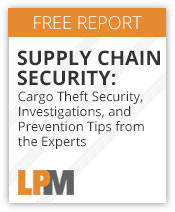Our friends at Loss Prevention Magazine recently asked Glenn Master (ISCPO board member and former Chairman) and John Tabor (ISCPO board member) how organizations can anticipate, prevent and investigate cargo theft as well as maintain logistics protocols that mitigate risk when it comes to supply chain security.
Protecting more than just merchandise
According to FreightWatch International, a risk management service provider, the average value of a stolen shipment in-transit can be around $300,000. One incident of organized retail crime, a problem we all consider a serious threat, nets about $8,000. Bank robbery? A pittance at about $2,000.
Efficient and effective supply-chain networks are necessary to successfully compete in the global retail market. It then rests on the loss prevention professional to take the necessary steps to gain a better understanding of the overall supply-chain process and how the process impacts the business so that he or she can effectively support shrink reduction and profit-enhancement efforts.
In terms of understanding, even the term “supply chain” can be viewed as a misnomer. This is not merely a seamless link of interconnected, proportional pieces that takes us from a point of origin and leads to a single ending destination.  It is a sophisticated, interdependent network of positions, processes, facilities, functions, responsibilities, tasks, transport, and technology that all culminates with delivering products and services to our customers.
It is a sophisticated, interdependent network of positions, processes, facilities, functions, responsibilities, tasks, transport, and technology that all culminates with delivering products and services to our customers.
From a loss prevention management perspective, our attentions must focus on disruptive risk. As described by one industry leader, “Assuming the enterprise has taken the necessary precautions to ensure product quality, integrity, and safety, the primary risk to any organization posed by the supply network is disruption. Any disruption in production or delivery will result in potential lost sales, decreased revenue, margin erosion, and profit loss.” These risks can exist at each origin location, at each intermediate location through which the product travels, and along each transportation link between points.
Companies must design operational plans that will serve to identify potential threats; evaluate how, when, and where they may occur; develop effective approaches to mitigate losses, and build programs that improve efficiency and business recovery. Theft is certainly a primary consideration, but specific risks will vary depending on a variety of factors specific to the unique supply-chain network. Potential risks must be identified and analyzed at each point along the network, building the plan that serves as the cornerstone of supply-chain resiliency.
Download this FREE Special Report from LP Magazine today!
 This in-depth, expert guide takes you through supply chain security and solutions where you’ll not only learn how theft occurs, but also where and when, and how you can fight it. You’ll…
This in-depth, expert guide takes you through supply chain security and solutions where you’ll not only learn how theft occurs, but also where and when, and how you can fight it. You’ll…
- Understand the threat to your organization that cargo theft represents
- Master the details of the entire supply-chain process
- Get up to speed on the LP pro’s role in stopping loss
- Pinpoint those stops along a shipment’s way where the danger is greatest – including your own distribution center
- Integrate supply-chain security knowledge into your day-to-day responsibilities
- Establish practices, processes and a company culture that will save your organization millions of dollars, and put your career on a fast track to success

